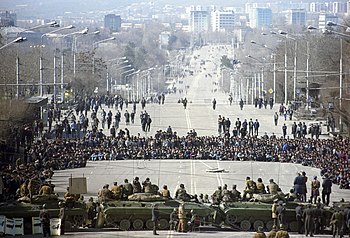| This article includes a list of general references, but it lacks sufficient corresponding inline citations. Please help to improve this article by introducing more precise citations. (August 2023) (Learn how and when to remove this message) |
| 1990 Dushanbe riots | |||
|---|---|---|---|
| Part of the dissolution of the Soviet Union | |||
 BMPs blocking off protesters in the city's main thoroughfare following the imposition of martial law, 14 February 1990 BMPs blocking off protesters in the city's main thoroughfare following the imposition of martial law, 14 February 1990 | |||
| Date | 12–14 February 1990 | ||
| Location | Dushanbe, Tajik SSR, Soviet Union 38°32′12″N 68°46′48″E / 38.53667°N 68.78000°E / 38.53667; 68.78000 | ||
| Caused by | Local anti-Armenian sentiment and Tajik anti-communist nationalism | ||
| Resulted in | Outbreak of the Tajikistani Civil War in 1992 | ||
| Parties | |||
| |||
| Lead figures | |||
| Casualties | |||
| Death(s) | 26 | ||
| Injuries | 565 | ||
  | |||
The 1990 Dushanbe riots marked a period of heightened civil disobedience and inter-ethnic violence in the capital city of the Tajik SSR of the Soviet Union. Existing tensions over lacking economic and political reforms were exacerbated by the arrival of Armenian refugees from the Azerbaijan SSR due to the Nagorno-Karabakh conflict. The mass movement of Tajik nationalists (e.g., the Rastokhez), anti-communists, and Islamists targeted ethnic minorities, such as Armenians, Russians, Jews, as well as unaffiliated Tajiks—namely women who did not conform to Islamic clothing standards. By late 1991, the dissolution of the Soviet Union gave way to the Republic of Tajikistan declaring independence, though this was followed by the Tajikistani Civil War less than a year later.
Causes
Armenian refugees
In 1988, in the aftermath of the Sumgait pogrom and anti-Armenian riots in Azerbaijan, 39 Armenian refugees from Azerbaijan were temporarily resettled in Dushanbe. In 1990, the Armenian influx became a subject of the rumour that triggered riots in Dushanbe. The rumour inflated the number of refugees to 2,500–5,000. According to rumour Armenians allegedly were being resettled in new housing in Dushanbe, which was experiencing an acute housing shortage at that time. Despite the fact that Armenian refugees resettled not in public housing but with their relatives, and by 1990 had already left Tajikistan for Armenia, official denouncement of the rumours was not able to stop the protests. Assurances by First Secretary of the Communist Party of Tajikistan Qahhor Mahkamov that no resettlement of Armenians were taking place were rejected by the demonstrators.
Economy, politics, and Islam
Soon, demonstrations sponsored by the nationalist Rastokhez movement turned violent. Radical economical and political reforms were demanded by the protesters. Government buildings, shops and other businesses were attacked and looted. Armenians, Russians, and other ethnic minorities were targeted. Abuse of Tajik women wearing European clothes in public also took place. The riots were put down by Soviet troops called into Dushanbe by Mahkamov. However Mahkamov's over-reliance on military force was criticized by Buri Karimov, a deputy chair of Council of Ministers, who called for the resignation of the leadership of the Tajik Communist Party. On February 14, 1990 Mahkamov and Prime Minister of Tajikistan Izatullo Khayoyev submitted their resignations, but they were not accepted by the Central Committee of the Tajik Communist Party.
Riots and other Central Asian SSRs
During the Dushanbe riots, a period lasting a couple of days, 26 people were killed and 565 were injured. Among the Tajik youth activists convicted for participation in the riots was a future minister of the interior of Tajikistan Yaqub Salimov. Smaller scale anti-Armenian incidents were also recorded in neighboring Turkmenistan.
Aftermath
Main article: Tajikistani Civil WarTajikistan would declare independence on 9 December 1991, from the collapsing Soviet Union. In 1992, a civil war would begin in the newly independent nation.
References
- ^ Horowitz, Donald L. (2002). The Deadly Ethnic Riot. University of California Press. p. 74. ISBN 0-520-23642-4. Retrieved 23 October 2008.
- Michael Waller; Bruno Coppieters; Alekseĭ Vsevolodovich Malashenko, eds. (1998). Conflicting Loyalties and the State in Post-Soviet Russia and Eurasia. Routledge. pp. 169–170. ISBN 0-7146-4882-5.
- Payin, Emil. "Settlement of ethnic conflicts in post-Soviet society". United Nations University Press. Archived from the original on 7 June 2007. Retrieved 23 October 2008.
- ^ Takeyh, Ray; Nikolas K. Gvosdev (2004). The Receding Shadow of the Prophet. Greenwood Publishing Group. ISBN 0-275-97629-7.
- Kolstø, Pål; Andrei Edemsky (1995). Russians in the Former Soviet Republics. Indiana University Press. p. 213. ISBN 0-253-32917-5.
- Collins, Kathleen (2006). Clan politics and regime transition in Central Asia. Cambridge University Press. pp. 155. ISBN 0-521-83950-5. Retrieved 23 October 2008.
Dushanbe riots islamists.
- ГАФАРЛЫ, МЕХМАН (25 February 2004). На родину в наручниках Россия экстрадировала в Душанбе бывшего главу МВД Таджикистана Якуба Салимова (in Russian). Novye Izvestiya. Archived from the original on 13 March 2010. Retrieved 23 October 2008.
- Allworth, Edward (1994). Central Asia, 130 Years of Russian Dominance. Duke University Press. pp. 586–587. ISBN 0-8223-1521-1. Retrieved 23 October 2008.
- 1990 riots
- Mass murder in 1990
- 1990 in Tajikistan
- Ethnic riots
- Anti-Armenian pogroms
- Riots and civil disorder in the Soviet Union
- Protests in the Soviet Union
- History of Dushanbe
- February 1990 events in the Soviet Union
- 1990 protests
- Anti-Russian sentiment in Asia
- Persecution of Christians by Muslims
- Racially motivated violence in Asia
- Massacres of the Nagorno-Karabakh conflict
- Tajikistani Civil War
- Anti-communist terrorism
- 1990s political riots